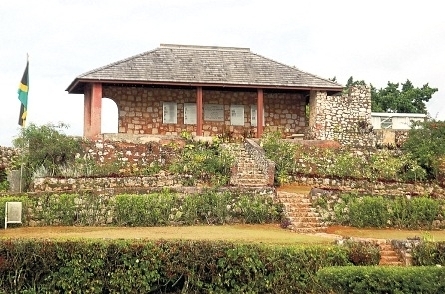Bloomfield Great House
Bloomfield Great House is situated on a property formerly known as the Bloomfield Estate. It precedes the formation of the parish of Manchester. In fact, the Mandeville Square now stands on land donated by four estates, one of which was Bloomfield.
The property passed through many phases of development being operated in the past as a coffee plantation, a citrus plantation, a cattle rearing farm and a dairy. The property was even at one time leased to Willing Mullings who used the Great House to operate a small hotel for a number of years. In 1925, the property was purchased by Guy Winchester Harris who effected a number of changes to the building which housed the hotel.
The property was sold in 1962 to Richard Harris who operated a dairy. The majority of the land was again sold in 1966. In 1972, Guy Barrington Grant purchased the property on which the Great House now stands. Today, the property is operated as a Restaurant and Gift Shop.
Roxborough
Roxborough, located in the parish of Manchester, is the birthplace of National Hero, the Right Excellent Norman Washington Manley.
This property was originally a part of an estate recorded as “Roxbro Castle”.
During the late Nineteenth Century, Thomas Albert Samuel Manley, father of Norman Manley, purchased a part of the property. On the 4th of July 1893 Norman Manley was born on the property. He lived there until 1903 when his father died and the family moved to their Belmont property at Guanaboa Vale.
It was proposed that the house be restored since it had fallen into disrepair but in 1968 it was destroyed by fire. Currently only the foundation remains. The Jamaica National Heritage Trust proposes to restore the building.
Mandeville Court House
The Mandeville Court House was built in 1817. It was constructed in the Jamaica Georgian style with two storeys, the top floor having columns, louvers and sash windows. A double spiral staircase leads from the lower storey on to a portico and the top storey.
Limestone blocks were used to build the court house. The original structure has not been changed over time and is still used as a court house with supporting offices on the premises.
The court house is actually the oldest building in the Mandeville Square, having been erected only two years after the town had been incorporated in 1815. Slave labour was used in the construction of this bastion of justice. The lower storey was used as the first school house during the early days of the town. In 1955, while on tour of the southern parishes, Princess Margaret was officially welcomed to the parish of Manchester, at the court house.
Manchester Club Golf Course
Built in 1865, the Manchester Club is believed to be the oldest surviving club in the western hemisphere.
It predates the Royal Montreal Club formed in 1873 and the Quebec Golf Club formed in 1875, both in Canada.
The Scots invented the game of golf; the earliest club formed outside of Scotland was the Royal Blackheath Golf Club of England formed in 1766, followed by the old Manchester Golf Club founded on the Kersal Moor in 1818 in England.
It is said that some of the planters who came to Jamaica from England played golf on pastures surrounding sugar estate lands for many years without any thought of forming a club or building a proper course.
It was in Manchester under the leadership of Dr. Nicholls that the game was first seriously taken up and a nine-hole course was laid down at Brumalia. After a somewhat chequered existence the club was incorporated in the Manchester Club under whose auspices the game took on a new lease on life. It was first established as an all male club in the tradition of a British Gentlemen’s Club. Access to membership had to be proposed and seconded by existing members – a quorum of six members being necessary to propose. Lots were cast using the white ball/black ball principle: six white balls would admit membership while five white and one black would deny membership.
Northern Caribbean University
West Indies College was born as a result of the Seventh Day Adventist Movement in Jamaica.
In 1907, a ninety acre farm was purchased at Willowdene in St. Catherine, but this was later sold to facilitate the purchase of 507 acres of land at Riversdale in the same parish, where West Indies College had its beginning.
The School began with 36 students. Unfortunately, the School closed in 1913, and all but 13 acres of the land was sold.
In 1919, the present school was started on the 181-acre Coolsworth property, two miles from the town of Mandeville. The School began in January of 1919 with five boarding students in a rented farmhouse called the Great House. The present wooden structure opposite Sorenson Hall was built from lumber at Riverside.
Heritage Sites by Parish
- Clarendon
- Hanover
- Kingston
- Portland
- St. Andrew
- St. Ann
- St. Catherine
- St. Elizabeth
- St. James
- St. Mary
- St. Thomas
- Trelawny
- Westmoreland
Learn more about Jamaican Heritage sites here.


